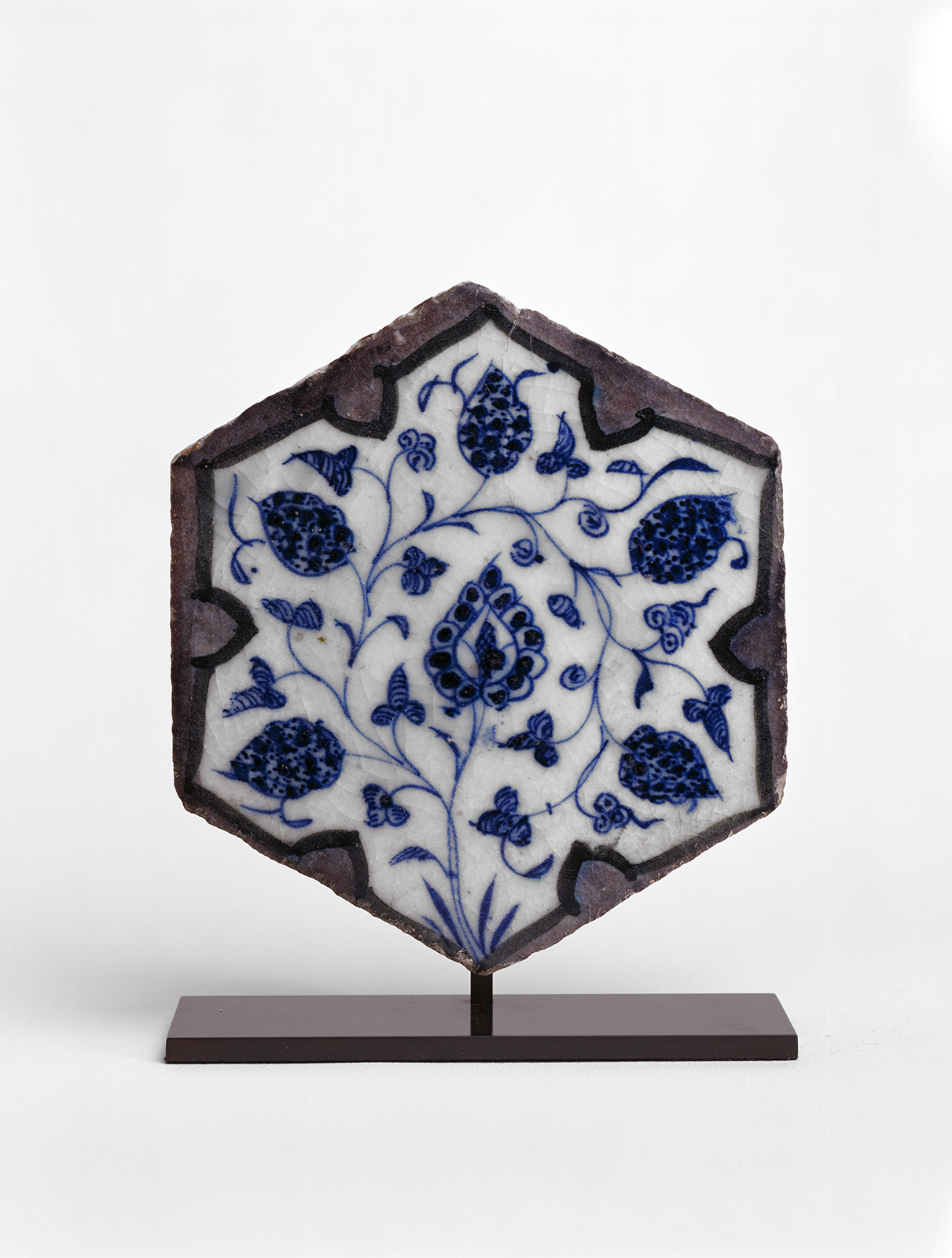Click on the image to zoom
Tile
- Accession Number:AKM581
- Place:Egypt or Syria
- Dimensions:19.4 x 17 cm
- Date:15th century
- Materials and Technique:fritware, underglaze-painted
This hexagonal shaped tile is underglaze-painted in cobalt blue, black, and dark manganese purple on a white ground. In its centre is a stylized lotus just at the point of opening, its cross-hatched centre framed by unfurling petals. These petals swirl around the lotus in a clockwise direction, encircled by a delicate scrolling tendril with five stylized leaves. Each leaf is densely filled with dark cobalt blue circles. The floral designs are surrounded by a scalloped border, with a lighter shade of purple added to the edge of the tile.
Further Reading
During the Mamluk period (1250-1517), Damascus in Syria and Cairo in Egypt were the most important centres for ceramic production. Their wares cannot easily be distinguished, though underglaze-painting seems to have been more prevalent in Syria.[1] Between the 13th and 16th centuries, workshops in both cities gained renown for developing new styles and techniques. Among these was the introduction of blue-and-white motifs that evoked the aesthetic of Chinese porcelain. It has commonly been assumed that blue-and-white hexagonal tiles were related to—or influenced by—Chinese blue-and-white porcelain imported into 15th-century Syria. However, careful examination confirms that the motifs were not direct copies of Chinese motifs but rather interpretations of pattern-books of Yuan porcelain, or portfolios of local traditions, which had already absorbed Chinese sources.[2]
The lotus flower is a distinguished decorative element in that regard; lotus flowers and peonies were well-established patterns from Asian culture that had been used throughout the Mongol Dynasties in Central Asia and also in Iran through the Ilkhanid dynasty (1256–1353) since the mid-14th century. Whether taking its models directly from China or indirectly from Iran, the so-called Khitai-Style was fashionable throughout the 15th century across a wide geography.
The distinctive design on this hexagonal tile in the Aga Khan Museum Collection can be found elsewhere. It appears in cobalt blue, in the interstitial zones between the points of a six-pointed star and the tile edge, on tiles found in the tomb of Ghars al-Din al-Khalil al-Tawrizi.[3] Tiles of comparable dimensions with similar and varied motifs can also be found in other collections, including the Tareq Rajab Museum in Kuwait[4] and the David Collection in Copenhagen.[5] In these cases, however, their colour palette differs, with turquoise appearing in place of dark manganese purple.
The hexagonal tile in the Aga Khan Museum Collection can be dated to the 15th century based on a group of hexagonal tiles with a manganese purple border discussed by Arthur Millner. Millner identifies these tiles as Damascene and dates them to the first half of the 15th century.[6]
— Filiz Çakır Phillip
Notes
[1] Geìza Feheìrvaìri, Ceramics of the Islamic World (London: IB Taurus, 2000), 246.
[2] Lisa Golombek, "The Paysage as Funerary Imagery in the Timurid Period," Muqarnas 10, Essays in Honor of Oleg Grabar (1993): 241. See also AKM874.
[3] John Carswell, "Six Tiles," Islamic Art in The Metropolitan Museum of Art, ed. Richard Ettinghausen (New York: The Metropolitan Museum of Art, 1972), 114–15.
[4] Feheìrvaìri, 250–251 [no. 311, CER1728TSR]).
[5] Kjeld von Folsach, Art from the World of Islam in The David Collection (Copenhagen: F. Hendriksens Eftf, 2001), 165 [no. 203].
[6] See Millner, Damascus Tiles: Mamluk and Ottoman Architectural Ceramics from Syria (New York: Prestel, 2015), fig. 3.38, p. 98. Geìza Feheìrvaìri has attributed these tiles to the 15th century but reiterates John Carswell’s conclusion that a place of production for these works remains uncertain. See Feheìrvaìri 251 and Carswell 75.
References
Carswell, John. "Six Tiles," Islamic Art in The Metropolitan Museum of Art, ed. Richard Ettinghausen. New York: The Metropolitan Museum of Art, 1972, 99 –124. ISBN: 9780870991110
Daiber, Verena, and Benoît Junod, eds. Schätze des Aga Khan Museum: Meisterwerke der islamischen Kunst. Berlin: Nicolai, 2010. ISBN: 9783894796037
Feheìrvaìri, Geìza. Ceramics of the Islamic World. London: IB Taurus, 2000. ISBN: 9781860644306
Golombek, Lisa. "The Paysage as Funerary Imagery in the Timurid Period," Muqarnas 10, Essays in Honor of Oleg Grabar (1993): 241–52. DOI: 10.2307/1523189
Junod, Benoît, Sheila Canby, et al. The Worlds of Islam in the Collection of the Aga Khan Museum. Barcelona: "La Caixa" Foundation and Aga Khan Trust for Culture, 2009. ISBN: 9788499000138
Millner, Arthur. Damascus Tiles: Mamluk and Ottoman Architectural Ceramics from Syria. New York: Prestel, 2015. ISBN: 9783791381473
Von Folsach, Kjeld. Art from the World of Islam in The David Collection. Copenhagen: F. Hendriksens Eftf, 2001. ISBN: 9788788464214
Note: This online resource is reviewed and updated on an ongoing basis. We are committed to improving this information and will revise and update knowledge about this object as it becomes available.


